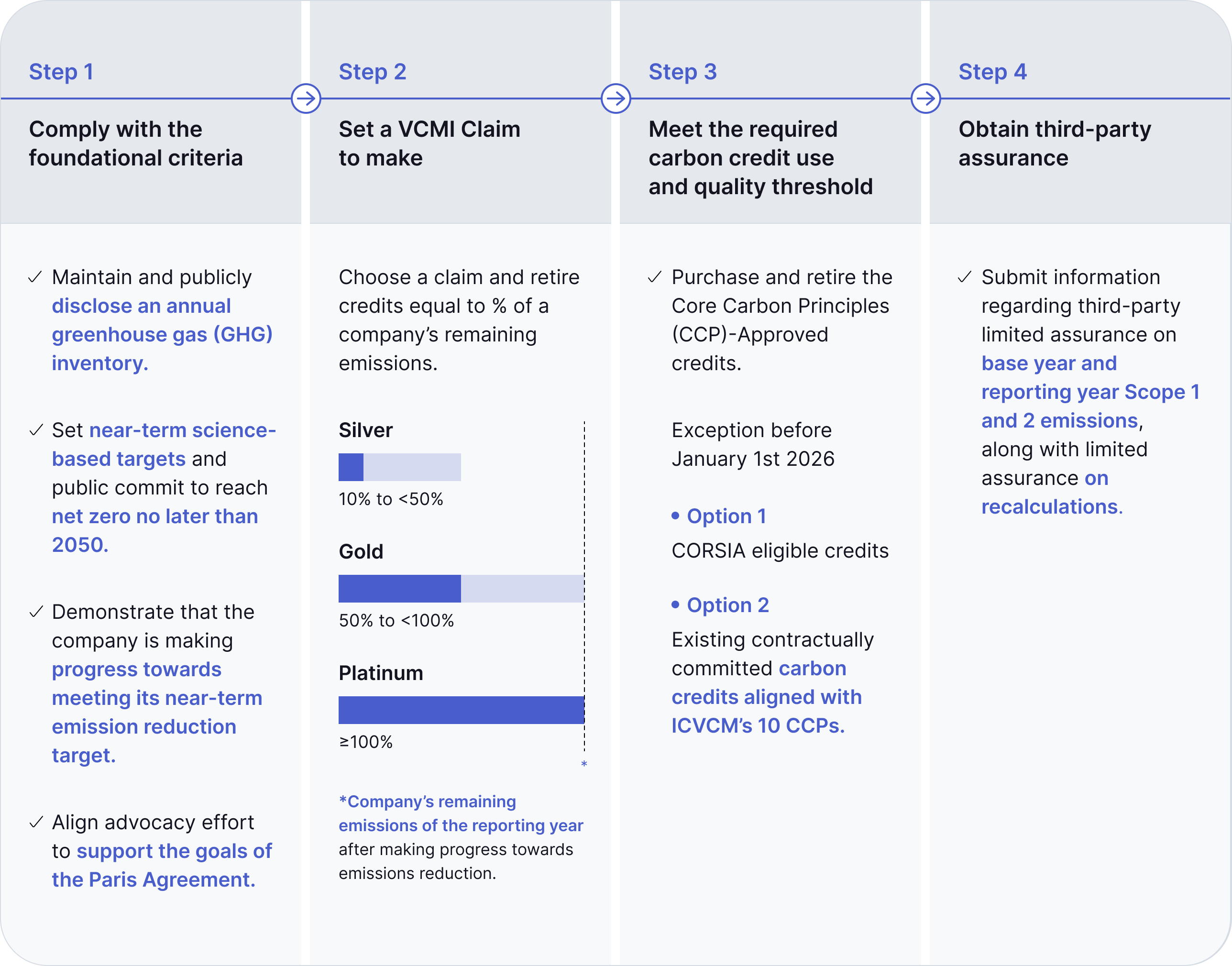The Voluntary Carbon Markets Integrity Initiative (VCMI) continues to pave the way for credible and transparent use of carbon credits. With the latest updates to its Claims Code of Practice and the introduction of the Scope 3 Flexibility Claim, VCMI is setting new standards for how companies can effectively and responsibly engage in carbon markets. It signals the urgent need to support the development of credible carbon projects, in addition to internal decarbonization efforts.
This comprehensive guide offers a nuanced examination of these updates, evaluating their implications for corporations and the broader impact.
What is VCMI?
VCMI is an international initiative that drives net-zero-aligned participation in the voluntary carbon market (VCM). The organization aims to build trust and confidence in how companies engage with the VCM, demonstrating their climate leadership. VCMI is also part of a collaboration launched during COP28, along with the Greenhouse Gas Protocol, CDP, Science Based Targets Initiative (SBTi), We Mean Business Coalition, and The Integrity Council for the Voluntary Carbon Market (ICVCM). This coalition aims to guide corporate climate actions, as they decarbonize internal operations and supply chains, and address remaining emissions with high-quality carbon credits.
Understanding the VCMI Claims Code of Practice
The VCMI Claims Code of Practice provides guidance to companies on the credible use of carbon credits and how to communicate their use as part of science-aligned net-zero decarbonization pathways. It is intended to infuse integrity and transparency into the VCM.
There are three levels of claims based on the percentage of a company's remaining emissions after they have made progress toward their near-term targets. Companies can demonstrate actions above and beyond their internal decarbonization efforts by purchasing and retiring high-quality carbon credits. These are:
- Silver: 10 – 50% of the company's remaining emissions
- Gold: 50 – 100% of the company's remaining emissions
- Platinum: 100% or greater of the company's remaining emissions
The four-step process in detail
To make these claims, companies must adhere to VCMI's foundational criteria, meet quality thresholds set by ICVCM’s Core Carbon Principles (CCPs), and follow the VCMI Monitoring Reporting and Assurance (MRA) Framework for disclosure requirement and third-party verification. The VCMI has refined a four-step process for corporates to make claims against their carbon credit purchases as shown below:

In addition to the four-step process, companies must submit their VCMI claim to VCMI Claims Reporting Platform within nine months post their financial year, including an assurance report. This submission also involves choosing their claim designation annually. For ease of reporting, the MRA framework has also aligned VCMI’s disclosure criteria for making claims with CDP, CSRD, IFRS, GRI, and TCFD. Companies can utilize the framework as a gap analysis to identify their disclosure gaps. At CEEZER, we also make it easy to gather all relevant data points and help companies fulfill disclosure requirements of VCMI and other reporting frameworks and standards.
While the guidance is an important milestone for the VCM, the vast majority of the companies still do not meet the foundational criteria, according to MSCI Carbon Markets (formerly Trove Research). Of over 470 companies using carbon credits, only 25% of companies have committed to net-zero by 2050, and only 38% of companies are on track to meet their near-term targets.
To date, only 445 companies have set a near-term target and are committed to achieving net-zero by 2050, according to SBTi. These companies will most likely be eligible for making VCMI claims, but many are yet to set a carbon credit purchasing strategy. It is still more challenging for small and medium enterprises to meet the foundational criteria.
The Transition to high-quality credits
A vital component of making a claim involves the purchasing and retiring of ICVCM CCP-approved carbon credits. However, CCP-approved credits are not yet available. As an interim solution before January 1, 2026, VCMI would accept CORSIA-eligible credits (a global emissions reduction scheme for aviation), existing contractually committed credits prior to 2026 supported by the company’s due diligence process in alignment with ICVCM’s 10 CCPs, which are:
- Additionality
- Permanence
- Robust quantification of emission reductions and removals
- No double counting
- Effective governance of carbon crediting program
- Tracking of mitigation activities on the registry
- Transparency of information provided by the carbon-crediting program
- Robust independent third-party validation and verification
- Sustainable development benefits and safeguards
- Contribution toward net-zero transition
Companies are mandated to publicly disclose detailed information for each credit they retire. This includes the number of credits, the due diligence processes, and information on the specific projects these credits are funding. Additionally, information on any co-benefit certifications such as CCB, SD VISta, or SDGs must also be disclosed. This level of transparency is key to fostering trust and integrity in the VCM.
While CCP-approved credits are not yet available, CEEZER is on the lookout for the latest developments with ICVCM and intends to label CCP-approved credits on our platform once released. Meanwhile, we align our rigorous project screening process with the 10 CCPs and support buyers through their due diligence process and reporting needs.
The Scope 3 Flexibility Claim - A Bridge for Emission Gaps
VCMI has also released a beta version of the Scope 3 Flexibility Claim for review. The Scope 3 Flexibility Claim is designed for companies struggling to meet their Scope 3 emission reduction targets. It allows them to use high-quality credits to bridge the gap between actual emissions and target levels, subject to specific conditions. As detailed within the Scope 3 Flexibility Claim Beta, companies are required to:
- Comply with the VCMI Foundational Criteria.
- Make progress towards meeting Scopes 1 and 2 emissions reduction targets.
- Use high-quality credits to bridge the gap between their most recently reported Scope 3 emissions and the expected Scope 3 emissions for the same year. The use of credits must not exceed a volume of 50% of a company’s GHG inventory scope 3 emission within the target boundary, and it must decline over time and completely phase out by 2035 or 10 years after the first claim is made, whichever is earlier.
- Disclose information on third-party assurance.
As it is still in development, companies are not yet able to make this claim. The final version of this claim is expected in 2024.
Navigating emerging trends in voluntary carbon markets
VCMI’s approach to claim-making is considered a “ton-for-ton” approach, meaning a company would purchase carbon credits in ton of CO2, to match per ton of unabated emissions. However, it does not motivate companies to prioritize higher-priced credits, which are some of the solutions that require climate finance to scale.
The SBTi public consultation on Beyond Value Chain Mitigation (BVCM) in June 2023 also explored other approaches for companies to participate in the VCM: money-for-ton and money-for-money.
- The money-for-ton approach allows companies to define an internal carbon price, and the total amount of climate finance for BVCM will be determined by the carbon price and unabated emissions.
- The money-for-money approach allows companies to allocate a share of revenue or profit toward financing climate mitigation beyond the value chain. However, some would argue that this is not compatible with the polluter pays principle, as it’s not directly linked to unabated emissions.
SBTi is expected to release new guidance on BVCM, which will provide crucial insights into the recommended approaches for companies seeking to engage in the VCM effectively. Along with the new collaboration among leading climate standards and frameworks announced at COP28, the VCM landscape continues to evolve.
Glossary
- Beyond Value Chain Mitigation (BVCM) - Actions or investments focused on mitigating greenhouse gas (GHG) emissions that occur outside an organization's direct operations. These can include initiatives to both prevent GHG emissions and to remove GHGs from the atmosphere. For example, a company might purchase carbon credits that support projects outside their immediate business processes.
- Carbon Offsetting and Reduction Scheme for International Aviation (CORSIA) - A global initiative aimed at reducing emissions in the international aviation sector. CORSIA works alongside other measures, like technological and operational enhancements and sustainable aviation fuels, to balance CO2 emissions that are challenging to eliminate by purchasing carbon credits from the market. This scheme is guided by criteria set by the International Civil Aviation Organization.
- CDP - A global non-profit organization that facilitates environmental reporting for businesses, governments, and other entities. Participants annually share data with CDP, detailing their strategies for addressing climate change, water security, and deforestation, thereby helping to track and manage environmental impacts.
- Integrity Council for the Voluntary Carbon Market (ICVCM) - This independent entity develops and enforces the Core Carbon Principles, setting a high standard for carbon credits in the voluntary market. The ICVCM is responsible for determining which carbon credit programs and categories meet these standards.
- Money-for-tonne - A financial strategy where a company, in line with its science-based emission targets, allocates funds to BVCM based on a set price per unit of its own unmitigated GHG emissions over a specific time frame. The funding amount is derived from the cost of carbon and the total emissions in that period.
- Money-for-money - A company commits a portion of its profits or revenue to climate mitigation efforts beyond its direct operations. The financial contribution to BVCM is calculated based on a selected percentage of the company's profits or revenue.
- Science Based Target Initiative (SBTi) - A collaborative project led by several global organizations, including CDP, encouraging companies to set emission reduction goals aligned with scientific understanding of climate change. The SBTi provides guidelines, tools, and an independent evaluation of corporate targets, helping companies align with the objectives of the We Mean Business Coalition.
- Ton-for-ton - A mitigation approach where a company matches its GHG emissions with equivalent mitigation efforts outside its value chain, based on a certain percentage of its emissions over a defined period. The financial commitment to BVCM is calculated using the cost per tonne of CO2 equivalent and the proportion of emissions being offset.
- Voluntary Carbon Markets Integrity Initiative (VCMI) - An international effort to ensure that voluntary carbon markets effectively contribute to the goals of the Paris Agreement. The VCMI focuses on ensuring that these markets are aligned with net-zero goals, and supports sustainable and inclusive development.
Connect with our team
While one might feel like guidances and frameworks are coming everywhere all at once, CEEZER is here to offer tailored insights and guidance. Identify eligible credits using our comprehensive set of filters aligned with standards and frameworks and build a portfolio aligned with your climate strategy. CEEZER also simplifies reporting requirements related to carbon credit purchases, enabling you to generate public pages containing key data from your carbon credit portfolios effortlessly.
In the ever-changing landscape of voluntary carbon markets, staying ahead of upcoming frameworks is crucial. To enhance your climate strategy by participating in voluntary carbon markets, please get in touch with us or book a demo today.





